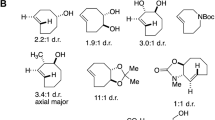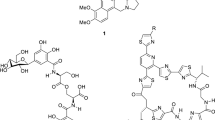Abstract
A sequence of reactions is presented for inverting the configurations of both epoxide carbons in 1,2-disubstituted epoxides. As examples, (+)-disparlure was converted to its enantiomer, (−)-disparlure, andexo-endo conversion of a cyclohexene oxide was demonstrated.
Similar content being viewed by others
References
Besse, P., Renard, M.F., andVeschambre, H. 1994. Chemoselective synthesis of chiral epoxides. Preparation of 4-phenyl-2,3-epoxybutane and 1-phenyl-1,2-epoxypropane.Tetrahedron Asymmetry 5:1249–1268.
Bierl, B.A., Beroza, M., andCollier, C.W. 1970. Potent sex attractant of the gypsy moth: Its isolation, identification, and synthesis.Science 170:87–89.
Corey, E.J., andLink, J.O. 1992. A new process for the enantioselective synthesis of chiral α-aryloxy and α-hydroxy acids.Tetrahedron Lett. 33:3431–3434.
Fleming, I. 1988. Stereocontrol in organic synthesis using silicon compounds.Pure Appl. Chem. 60:71–78.
Ogliaruso, M.A., andWolfe, J.F. 1993. Synthesis of lactones and lactams, pp. 19–30,in S. Patai and Z. Rappoport (eds.). John Wiley & Sons, New York.
Olah, G.A., Fung, A.P., andMeidar, D. 1981. synthetic methods and reactions; 68. Nafion-H-catalyzed hydration and methanolysis of epoxides.Synthesis 1981:280–282.
Oliver, J.E., andWaters, R.M. 1995. Determining enantiomeric composition of disparlure.J. Chem. Ecol. 21:199–211.
Plimmer, J.R., Schwalbe, C.P., Paszek, E.C., Bierl, B.A., Webb, R.E., Marumo, S., andIwaki, S. 1977. Contrasting effectiveness of (+) and (−) enantiomers of disparlure for trapping native populations of gypsy moth in Massachusetts.Environ. Entomol. 6:518–522.
Posner, G.H., andRogers, D.Z. 1977. Organic reactions at alumina surfaces. Mild and selective opening of arene and related oxides by weak oxygen and nitrogen nucleophiles.J. Am. Chem. Soc. 99:8214–8218.
Rylander, P. 1979. Catalytic Hydrogenation in Organic Synthesis. Academic Press, New York. p. 271.
Sonnet, P.E., andOliver, J.E. 1976a. Olefin inversion. I. Reaction of aliphatic epoxides with triphenylphosphine dihalides.J. Org. Chem. 41:3279–3283.
Sonnet, P.E., andOliver, J.E. 1976b. Olefin inversion. 2. Sodium iodide reductions of vicbromochlorides and vic-dichlorides.J. Org. Chem. 41:3284–3286.
Valega, T.M., andBeroza, M. 1967. Structure-activity relationships of some attractants of the Mediterranean fruit fly.J. Econ. Entomol. 60:341–347.
Author information
Authors and Affiliations
Rights and permissions
About this article
Cite this article
Oliver, J.E., Waters, R.M. & Harrison, D.J. Semiochemicals via epoxide inversion. J Chem Ecol 22, 287–294 (1996). https://doi.org/10.1007/BF02055099
Received:
Accepted:
Issue Date:
DOI: https://doi.org/10.1007/BF02055099




